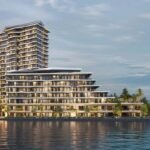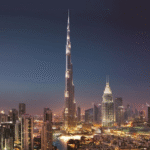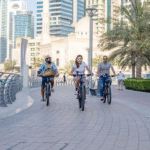Now Reading: Urban Tech District Dubai Leads Smart Infrastructure
-
01
Urban Tech District Dubai Leads Smart Infrastructure
Urban Tech District Dubai Leads Smart Infrastructure

Urban Tech District Dubai at Al Jaddaf is shaping up to be one of the city’s most forward-looking infrastructure projects, aiming to transform how technology, sustainability, and urban living come together. Envisioned as a hub for innovation, research, and entrepreneurship, the development seeks to position Dubai as a leader in smart infrastructure solutions. It aligns with the emirate’s long-term strategies to diversify its economy, attract global talent, and become a model for future-ready cities.
What Is the Urban Tech District Dubai?
The Urban Tech District Dubai is a large-scale development planned in Al Jaddaf, a location chosen for its connectivity and central position along Dubai Creek. Designed as an ecosystem for smart city innovation, the district will bring together tech firms, research institutions, entrepreneurs, and government bodies under one umbrella.
The project focuses on:
- Smart Infrastructure Innovation: Encouraging the creation of intelligent solutions for transportation, energy, and water systems.
- Green Urban Planning: Incorporating sustainable building designs, renewable energy sources, and eco-friendly transport.
- Entrepreneurship and Research: Providing coworking spaces, labs, and incubation hubs for startups and innovators.
- Global Collaboration: Serving as a base for international companies seeking to expand in the Middle East.
Why Al Jaddaf Was Chosen
Al Jaddaf, located near Dubai Creek, is strategically positioned between the city’s old and new urban centers. Its location makes it a symbolic and practical choice for the Urban Tech District Dubai.
- Connectivity: Close to Dubai International Airport, major highways, and Dubai Metro lines.
- Urban Growth: Al Jaddaf is already home to cultural landmarks, healthcare facilities, and mixed-use developments.
- Central Role: Its position allows the district to act as a bridge between historic Dubai and future-focused smart city developments.
Driving Smart Infrastructure Innovation
The Urban Tech District Dubai is not just about constructing buildings it’s about building an ecosystem. The focus on smart infrastructure innovation means developing solutions that improve how cities function and how residents interact with their environment.
Key areas of innovation include:
- Smart Transportation: Integrating autonomous vehicles, EV infrastructure, and AI-powered traffic management.
- Energy Solutions: Expanding solar power usage, battery storage, and intelligent energy distribution systems.
- Water Management: Deploying sensors and AI to reduce waste and ensure sustainable water use.
- Urban Data Platforms: Creating real-time data systems to monitor city operations, from public safety to environmental conditions.
Alignment with Dubai’s Vision
Dubai has positioned itself as a global leader in innovation, and the Urban Tech District Dubai supports its broader strategies, including:
- Dubai 2040 Urban Master Plan: Creating sustainable, resilient, and people-centered urban environments.
- Dubai Clean Energy Strategy 2050: Aiming for 75% of Dubai’s energy to come from clean sources by mid-century.
- Smart Dubai Initiative: Making Dubai the happiest and smartest city in the world through digital transformation.
By creating a dedicated hub, the emirate ensures that infrastructure innovation is embedded in its growth model.
Attracting Talent and Investment
The Urban Tech District Dubai is designed to attract top-tier talent, global investors, and forward-thinking companies. Benefits include:
- Access to Funding: Venture capital firms and investment bodies will be integrated into the ecosystem.
- Innovation Clusters: The district will house themed clusters for AI, robotics, cleantech, and smart construction.
- Partnership Opportunities: Startups and multinational companies will collaborate on projects that address global urban challenges.
- Global Appeal: Positioned in Dubai, a hub for international business, the district will appeal to entrepreneurs from Asia, Europe, and North America.
Impact on Real Estate and Infrastructure
Projects like the Urban Tech District Dubai also have significant implications for the property sector.
- Rising Property Demand: Homes and offices around Al Jaddaf are expected to see increased demand.
- Mixed-Use Development: The district will feature commercial, residential, and leisure spaces, making it a vibrant urban community.
- Smart Homes and Workspaces: Integration of advanced technologies will become standard, appealing to modern residents and businesses.
Sustainability at the Core
A central element of the Urban Tech District Dubai is its focus on sustainability. Every aspect of the development, from construction to operations, is designed to reduce environmental impact.
- Green Buildings: Designed according to LEED and other international sustainability standards.
- Renewable Energy: Heavy reliance on solar energy and smart grids.
- Eco-Friendly Transport: Electric buses, cycling paths, and pedestrian-friendly streets.
- Circular Economy Practices: Recycling, waste reduction, and reusing resources wherever possible.
Global Relevance of Urban Tech District Dubai
The challenges of rapid urbanization are not limited to Dubai they are global. From congestion in mega-cities to the need for clean energy, the solutions developed at Urban Tech District Dubai could be replicated worldwide. The district could become a global export hub for urban technologies, contributing not only to Dubai’s economy but also to global city development.
Future Outlook
Looking ahead, the Urban Tech District Dubai is poised to play a central role in Dubai’s transition to a knowledge-based economy. By fostering innovation, sustainability, and entrepreneurship, it could redefine what modern infrastructure means for urban living.
Key future expectations include:
- Becoming the largest hub for smart city technology in the Middle East.
- Attracting international conferences, exhibitions, and forums on urban innovation.
- Serving as a testing ground for new technologies before global rollout.
- Acting as a catalyst for wider adoption of sustainable infrastructure across Dubai and beyond.
Conclusion
Urban Tech District Dubai at Al Jaddaf represents more than just another development it is a vision of the future. By leading smart infrastructure innovation, it will not only elevate Dubai’s standing as a global city but also provide solutions to some of the most pressing urban challenges of our time. For residents, investors, and innovators, the district is a promise of a smarter, greener, and more connected tomorrow.
Follow us on: Instagram
Read More-UAE Real Estate Regulations Target Money Laundering






















